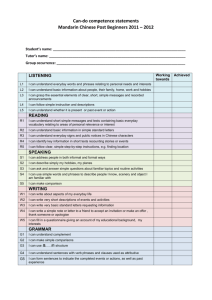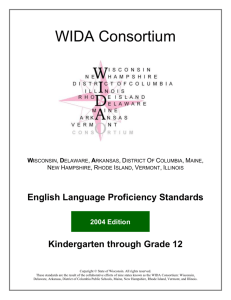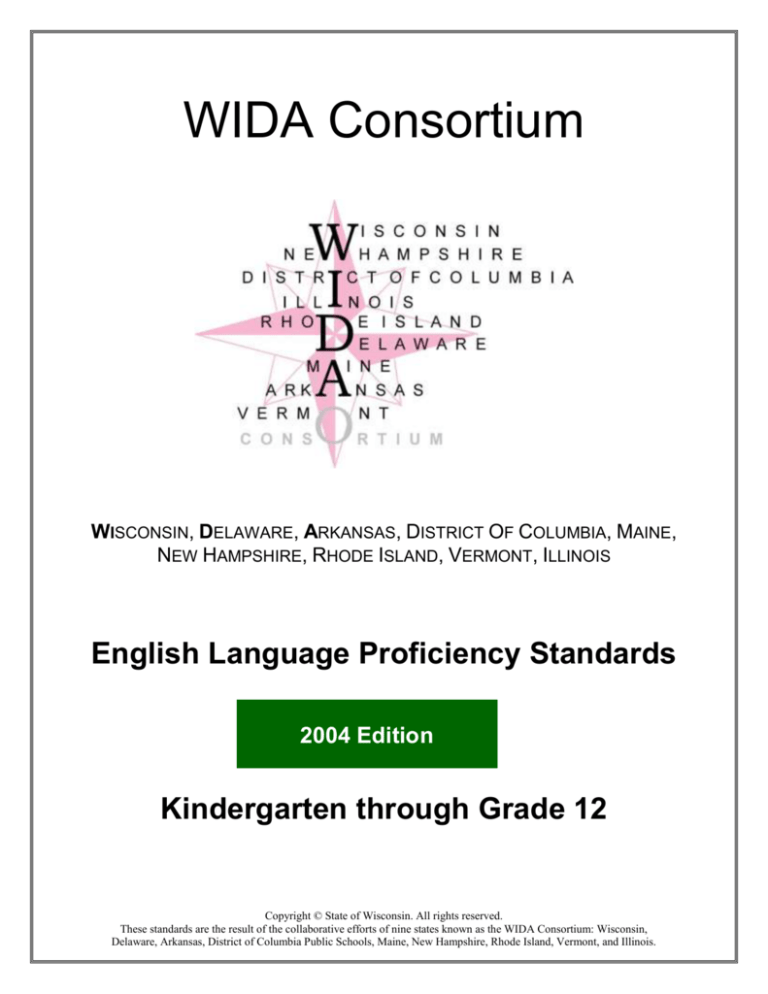
WIDA Consortium
WISCONSIN, DELAWARE, ARKANSAS, DISTRICT OF COLUMBIA, MAINE,
NEW HAMPSHIRE, RHODE ISLAND, VERMONT, ILLINOIS
English Language Proficiency Standards
2004 Edition
Kindergarten through Grade 12
Copyright © State of Wisconsin. All rights reserved.
These standards are the result of the collaborative efforts of nine states known as the WIDA Consortium: Wisconsin,
Delaware, Arkansas, District of Columbia Public Schools, Maine, New Hampshire, Rhode Island, Vermont, and Illinois.
English Language Proficiency Standard 1: English language learners communicate in English for
SOCIAL AND INSTRUCTIONAL purposes within the school setting.
Domain:
Grade Level
Cluster
Level 1
Entering
Level 3
Beginning
Level 4
Developing
Level 5
Expanding
Bridging
identify symbols found in
classrooms and schools
from pictures and oral
statements (such as
“Office” or “Exit”)
identify or locate areas of
the classroom and school
described orally with
visual support (such as
corner, library, or
hallway)
match school personnel
with oral descriptions of
their job functions (such
as answer the phone in
the office or serve food)
identify school-related
activities from oral
descriptions (such as
field trips or
assemblies)
match oral
descriptions of
school personnel
with individual
needs or situations
(e.g., “If…then;”
“Suppose…”)
follow one step oral
commands
follow multi-step oral
commands
follow directions from
oral discourse
respond (non-verbally) to
questions, statements,
commands, or social
courtesies given orally
identify topics, some
words, or phrases of oral
communications
follow multi-step oral
commands that
incorporate language of
polite requests (e.g., “I
wish that you could;
would you please…”)
identify the main
idea(s) and literal
details of oral
discourse
follow directions
from indirect oral
discourse (such as
using a cassette tape)
identify the main
idea(s) and implied
details of oral
discourse
identify the main idea(s)
of multiple-sentence
communication
identify needed resources
to complete assignments
based on pictures and
oral statements (such as
pencils, rulers, or
computers)
match needed resources
with types of
assignments based on
pictures and oral
statements (such as
calculators or math
books)
categorize needed
resources with types of
assignments based on
pictures and oral
descriptions
analyze assignments
and match with needed
resources based on oral
discourse
evaluate and select
the most appropriate
resources needed to
complete
assignments based
on oral discourse
respond (non-verbally) to
commands pertaining to
classroom routines
(e.g., “Close your
book.”)
respond (non-verbally) to
questions pertaining to
multiple-step classroom
instructions (e.g., “What
is the last word on page
45 of the dictionary?”)
respond (non-verbally) to
explicit language
pertaining to classroom
instructions
respond (non-verbally)
to idiomatic
expressions pertaining
to classroom
instructions (e.g.,
“What do you do when
you hit the books?”)
respond (nonverbally) to
figurative language
pertaining to
classroom
instructions (such as
to the use of
hyperboles or
metaphors)
6-8
9-12
Level 2
K-2
3-5
LISTENING — process, understand, interpret, and evaluate spoken language in a variety of situations
FRAMEWORK FOR LARGE-SCALE ASSESSMENT
Copyright © 2004 State of Wisconsin. All rights reserved.
1a
English Language Proficiency Standard 1: English language learners communicate in English for
SOCIAL AND INSTRUCTIONAL purposes within the school setting.
Domain: SPEAKING — engage in oral communication in a variety of situations for a variety of purposes and audiences
Grade Level
Cluster
Level 3
Level 4
Level 5
Developing
Expanding
Bridging
identify and name
everyday objects
described orally with
visual support (such as
classroom supplies or
household items)
tell the uses of everyday
objects depicted
visually
sort everyday objects
depicted visually and
explain their uses
compare/contrast the
uses of everyday
objects
judge and justify the
effectiveness of the
uses of everyday
objects
provide identifying
information
make personal
introductions
exchange personal
information
restate personal
information
summarize personal
information
respond to WHquestions
ask and respond to
questions
ask questions and express
ideas in response
ask questions and
respond with related
or connected ideas
ask and respond to
questions with ease
and fluency
repeat, restate, or
respond to oral
instructions or
assignments
paraphrase or retell oral
instructions,
assignments, or stories
summarize oral
instructions, assignments,
or stories
analyze oral
instructions,
assignments, or
stories using detailed
descriptions
analyze and explain
oral instructions,
assignments, or
stories appropriate
for grade level
answer questions that
express likes and
dislikes
answer a range of
questions that express
personal preferences
express personal
preferences or points of
view
express and defend
personal preferences,
opinions, or points of
view
express and defend
points of view other
than from a personal
perspective
6-8
9-12
Level 2
Beginning
K-2
3-5
Level 1
Entering
FRAMEWORK FOR LARGE-SCALE ASSESSMENT
Copyright © 2004 State of Wisconsin. All rights reserved.
2a
English Language Proficiency Standard 1: English language learners communicate in English for
SOCIAL AND INSTRUCTIONAL purposes within the school setting.
Domain: READING — process, interpret, and evaluate written language, symbols, and text with understanding and fluency
Grade Level
Cluster
Level 1
Entering
Level 3
Beginning
Level 4
Developing
Level 5
Expanding
Bridging
identify environmental
print (such as signs
around school or the
community)
extract information from
environmental print (such
as signs, bulletin boards,
or menus)
restate information
found in visually
supported print (such as
school schedules, field
trips, or celebrations)
summarize
information found in
visually supported
print on classroom or
school activities
interpret rules and
procedures (such as
from the classroom or
school)
identify topics from
pictures, words, or
phrases (such as daily
routines associated with
time periods)
identify explicit messages
from visually supported,
non-technical text (such
as from language
experience stories)
identify main ideas
from visually
supported, explicit text
(such as from school
permission slips, notes
about school events)
identify main ideas
and major details
(such as from school
announcements, dress
or discipline codes)
make inferences
about main ideas and
use details as
supporting evidence
(such as from comic
books)
locate facts or
information on sociallyrelated topics (such as
the school dance)
connect facts or
information on sociallyrelated topics to examples
compare/contrast facts
or information on
socially-related topics
interpret facts or
information on
socially-related topics
summarize everyday
information, supported
by visuals (such as on
billboards, ads, or
instructions)
match everyday
information to visuals
identify main idea from
everyday information
supported by visuals
identify details or
related information
that support the main
idea
apply facts or
information on
socially-related topics
to new situations
infer what to do
based on everyday
information
identify text features or
web resources used for
assignments
(such as titles or
authors)
match text features or web
resources with their uses
for assignments
(such as use a Table of
Contents to find topics)
match types of books or
web resources with
information needed for
assignments
scan entries in books
or web sites to locate
information for
assignments
K-2
3-5
6-8
9-12
Level 2
FRAMEWORK FOR LARGE-SCALE ASSESSMENT
Copyright © 2004 State of Wisconsin. All rights reserved.
use text features or
web resources to
confirm information
for assignments
(such as indexes or
glossaries)
3a
English Language Proficiency Standard 1: English language learners communicate in English for
SOCIAL AND INSTRUCTIONAL purposes within the school setting.
Domain: WRITING — engage in written communication in a variety of forms for a variety of purposes and audiences
Grade Level
Cluster
Level 2
Level 3
Level 4
Level 5
Entering
Beginning
Developing
Expanding
Bridging
trace, copy, or produce
words about self
make lists for varying
purposes related to self
relate personal facts
compose friendly
notes or personal
messages
narrate or compose
personal stories with
illustrations
label or produce icons
for school rules or
procedures
list dos and don’ts
regarding school rules
or procedures
give examples of school
rules or procedures
compose using pictures,
labels, and phrases
compose using phrases
and simple sentences
compose using expanded
sentences with some
complexity
explain the
usefulness or
importance of school
rules or procedures
discuss or propose
consequences of
breaking school rules
or procedures
compose using a
variety of sentence
lengths and levels of
complexity
compose using a
variety of sentence
lengths and levels of
complexity with clear
meaning
make lists of words
associated with school
subjects
outline or complete
organizers with school
schedule and subjects
describe a typical school
day and discuss favorite
school subjects
suggest ideas for
making changes in
school, such as
rearranging a
schedule or adding
subjects (e.g., “I
would like to…”)
write a proposal to
add school subjects
and give reasons for
choices
complete forms read
orally with identifying
information or produce
facts about self
complete real life forms
(such as leases,
applications, licenses)
create announcements,
invitations, or form
paragraphs stating who,
what, when, and why
make requests,
apologize, or
compose or respond
to e-mails or personal
messages in extended
paragraphs
compose social
letters, editorials,
advice columns,
reviews, or resumes
K-2
3-5
6-8
9-12
Level 1
FRAMEWORK FOR LARGE-SCALE ASSESSMENT
Copyright © 2004 State of Wisconsin. All rights reserved.
4a
English Language Proficiency Standard 2: English language learners communicate information, ideas, and
concepts necessary for academic success in the content area of LANGUAGE ARTS.
Domain: LISTENING — process, understand, interpret, and evaluate spoken language in a variety of situations
Grade Level
Cluster
Level 1
Entering
Level 3
Beginning
Level 4
Developing
Level 5
Expanding
Bridging
match pictures to
sentences read aloud
order pictures of related
sentences read aloud
using ordinal numerals
(such as first, second,
last)
sequence pictures of
stories read aloud by
beginning, middle, and
end
reproduce stories
read aloud through a
series of pictures
sequence a series of
pictures of
incomplete stories
read aloud and select
logical outcomes or
endings
identify elements of
stories from oral
directions supported by
illustrations (such as
characters or settings)
select literal meanings
from oral descriptions
(such as from oral
reading of realistic
fiction) and match to
illustrations
identify the main idea(s)
or make predictions from
oral discourse (such as
from oral reading of
realistic or science
fiction) and select from
illustrations
identify cause/ effect
in oral discourse
(such as from oral
reading of realistic or
science fiction)
make connections
and draw conclusions
from oral discourse
(such as from oral
reading of grade level
realistic or science
fiction)
identify words and
phrases related to
different time frames
following oral
directions with visual
support (e.g., “before,”
“during,” “after”)
match oral phrases,
sentences, or
paragraphs supported
visually with different
time frames
(e.g., “Long ago; right
now; in the future.”)
identify use of literary
devices related to
different time frames in
passages read orally (such
as foreshadowing or
flashback)
analyze use of
literary devices
related to different
time frames found in
short stories read
orally
interpret use of
literary devices
related to different
time frames from
grade level language
arts oral reading
identify and locate
sources of information
based on oral directions
and visual support
select or sort sources of
information based on
oral descriptions and
visual support
compare and contrast
sources of information
based on oral discourse
connect information
from various sources
based on oral
discourse
evaluate information
from various sources
based on oral
discourse
K-2
3-5
6-8
9-12
Level 2
FRAMEWORK FOR LARGE-SCALE ASSESSMENT
Copyright © 2004 State of Wisconsin. All rights reserved.
5a
English Language Proficiency Standard 2: English language learners communicate information, ideas, and
concepts necessary for academic success in the content area of LANGUAGE ARTS.
Domain: SPEAKING — engage in oral communication in a variety of situations for a variety of purposes and audiences
Grade Level
Cluster
Level 2
Level 3
Level 4
Level 5
Beginning
Developing
Expanding
Bridging
name characters or
settings of stories from
(wordless) picture
books or short stories
describe characters or
settings of stories from
(wordless) picture
books or short stories
identify features of
illustrations and
photographs
describe features of
illustrations and
photographs
name story elements of
various genres depicted
visually (such as nonfiction works, fairy
tales, myths, fables, or
legends)
describe explicit story
elements of various
genres supported by
illustrations (such as
non-fiction works, fairy
tales, myths, fables, or
legends)
answer WH- questions
from pictures related to
biographies or human
interest stories
describe pictures related
to biographies or
human interest stories
state facts related to the
news or information in
visually supported
magazines or
newspapers read orally
differentiate opinions
from facts related to
information in visually
supported magazines or
newspapers read orally
K-2
3-5
6-8
9-12
Level 1
Entering
outline plots or themes of
stories from picture books
or short stories
narrate main events
of plot sequences and
state main idea from
picture books or short
stories
predict what a story is
about from visual and oral
prompts
predict what will
happen next from
oral prompts
summarize issues or
conflicts in various
genres, supported by
illustrations (such as nonfiction works, fairy tales,
myths, fables, or legends)
relate information from
graphic organizers on
biographies or human
interest stories
provide facts and opinions
to articulate arguments
related to editorials, or
reviews read orally (such
as books or movies)
FRAMEWORK FOR LARGE-SCALE ASSESSMENT
Copyright © 2004 State of Wisconsin. All rights reserved.
re/tell stories using
story grammar from
picture books or short
stories
state alternative
endings to grade level
stories from oral
prompts
discuss relationships
among ideas and
offer opinions on
issues in various
genres (such as nonfiction works, fairy
tales, myths, fables,
or legends)
make connections
and propose options
or solutions to issues
or conflicts in various
genres and support
with details
summarize points
from outlines derived
from biographies or
human interest stories
create impromptu
speeches from notes
derived from grade
level biographies or
human interest stories
critique in detail
editorials, reviews, or
literary works read
orally
debate issues with
coherent arguments
related to editorials,
critiques, reviews, or
literary works read
orally
6a
English Language Proficiency Standard 2: English language learners communicate information, ideas, and
concepts necessary for academic success in the content area of LANGUAGE ARTS.
Domain: READING — process, interpret, and evaluate written language, symbols, and text with understanding and fluency
Grade Level
Cluster
Level 3
Level 4
Level 5
Developing
Expanding
Bridging
match labels or identify
facts from pictures and
phrase
(e.g., “I see, there is…”)
locate organizational
features of visually
supported texts
(such as headings,
paragraphs, or format)
respond to literal
questions from
illustrations or visually
supported text
identify word patterns in
context
identify words and
phrases related to author’s
purpose
match key vocabulary
within graphic supported
texts to visuals
3-5
9-12
Level 2
Beginning
associate letter sounds (at
beginning, middle, or end
of words) with familiar
pictures in context
K-2
6-8
Level 1
Entering
match letters/ diagraphs
within and across words
(such as
common rhyming
words or word families)
with pictures
identify language
associated with stating
facts found in short
fiction or non-fiction
text supported by
pictures or graphics
(e.g., “I know that…,”
“it is true that…”)
differentiate among
organizational features
of texts (such as indices
and glossaries)
predict outcomes from
visually supported text
use knowledge of
affixes or root words to
determine meaning in
context
sort words and phrases,
with visual support, into
phonological or semantic
categories
identify language
associated with stating
opinions found in fiction
or non-fiction text (e.g., “I
think that...;” “We believe
that…;” “It could be...”)
identify ideas related to
author’s purpose
locate key facts in
graphics and texts
use organizational
features of texts to glean
main ideas (such as bold
print)
confirm predictions and
make generalizations
from visually supported,
explicit text
use context clues to
determine word meanings
(such as for homonyms or
metaphors)
identify ideas and
supporting details related
to author’s purpose
summarize information in
graphics and texts
FRAMEWORK FOR LARGE-SCALE ASSESSMENT
Copyright © 2004 State of Wisconsin. All rights reserved.
match words and
phrases with pictures
or other visual
support (such as
graphics, charts, or
visual organizers)
differentiate between
statements of fact and
opinion found in
various reading
selections
match sentences with
pictures or other
visual support (such
as graphics, charts, or
visual organizers)
identify authors’
reasons or intent for
selecting facts or
opinions found in
fiction or non-fiction
from grade level
language arts text
use organizational
features of texts to
compare/contrast
ideas
make inferences from
text
identify figures of
speech (such as
similes, alliteration,
or personification)
analyze information
related to author’s
purpose
make generalizations
from explicit and
implicit literary texts
apply knowledge of
organizational
features of texts to
summarize ideas
draw conclusions
from explicit and
implicit text
apply knowledge of
structural analysis,
cognates, or context
to determine word
meanings
interpret author’s
purpose and apply to
other contexts
identify extended
analogies,
symbolism, or
abstract ideas in
literary texts
7a
English Language Proficiency Standard 2: English language learners communicate information, ideas, and
concepts necessary for academic success in the content area of LANGUAGE ARTS.
Domain: WRITING — engage in written communication in a variety of forms for a variety of purposes and audiences
Grade Level
Cluster
Level 2
Level 3
Level 4
Level 5
Beginning
Developing
Expanding
Bridging
draw pictures in
sequential order in
response to stories read
orally
produce pictures and
words to depict
sequence in stories
produce phrases in
sequential order to relate a
series of events in stories
use sequential
language in sentences
to relate a series of
events in stories (e.g.,
“First…. Then…”)
use language of
storytelling to relate a
series of events
(e.g., “Once upon a
time…”)
describe personal
experiences using
pictures, words, or
phrases
relate personal
information or
experiences using
limited descriptive
language
compare/contrast personal
information or
experiences with those of
others using descriptive
language
compose personal
narratives or
autobiographical
sketches
produce pieces that
make personal
connections or
integrate personal
experiences with
literature (such as
assume character’s
role or relate to
events)
produce symbols,
words, or phrases to
convey basic
information
produce notes,
construct charts or
graphic organizers to
convey information
construct paragraphs to
convey information (such
as produce journal
entries)
create original ideas
by synthesizing
information
defend positions or
stances using original
ideas with supporting
details
copy facts pertaining to
current events or issues
extract key phrases or
sentences from written
texts
take notes or produce
outlines from written texts
rewrite stories on
current events or
issues in different
time frames
produce key words or
phrases from written
texts
produce editorial
comments on current
events or issues
express opinions or
reactions to current
events or issues
summarize notes
from written texts in
paragraph form
rewrite stories on
current events or
issues from different
perspectives or points
of view
produce essays and
reports from notes or
outlines
K-2
3-5
6-8
9-12
Level 1
Entering
FRAMEWORK FOR LARGE-SCALE ASSESSMENT
Copyright © 2004 State of Wisconsin. All rights reserved.
8a
English Language Proficiency Standard 3: English language learners communicate information, ideas, and
concepts necessary for academic success in the content area of MATHEMATICS.
Domain: LISTENING — process, understand, interpret, and evaluate spoken language in a variety of situations
Grade Level
Cluster
Level 2
Level 3
Level 4
Level 5
Beginning
Developing
Expanding
Bridging
identify illustrations of
math figures described
orally
(e.g., “Find a shape that
looks like the sun.”)
identify illustrations of
math figures whose
attributes are described
orally (e.g., “Find a
shape with 4
sides.”[such as a door
or window])
complete repeated math
patterns of alternating
figures described orally
complete repeated
math patterns
described orally
(such as + + - -☺☺ )
predict sequence of
complex math
patterns from oral
descriptions
according to grade
level
identify quantities,
math symbols,
operations, or
geometric attributes
from oral statements
and illustrations
(such as shape or size)
compare quantities or
attributes based on oral
directions, illustrations,
or statements using
contrastive language
(such as longer, shorter,
greater or less than)
identify examples of
mathematical terms
based on oral descriptions
of their properties or
attributes (such as
differentiate among
geometric figures based
on length, width, or
height)
apply language of
formulas required for
problem solving or
data analysis as
directed orally
construct models of
geometric figures,
real-world problems,
numerical functions
or patterns based on
grade level
mathematical oral
discourse
match proportional
representation of
objects with oral
directions and
illustrations (such as
percent, fractions, or
decimals; e.g., “Which
___ shows ___?”)
follow multi-step
directions to identify
proportional
representation in graphs
match examples of uses of
proportion with oral
descriptions (such as
interest or taxes; e.g.,
“If…then...”)
analyze and apply the
use of proportion
from oral word
problems
evaluate ways of
using proportion to
solve grade level oral
word problems
select problem-solving
tools from oral
statements and visual
support
select problem-solving
methods and tools from
oral descriptions and
visual support
select problem-solving
methods and tools to
address everyday
experiences described
orally
select problemsolving methods and
tools from extended
oral discourse
select problemsolving methods and
tools from oral
reading of grade level
math text
K-2
3-5
6-8
9-12
Level 1
Entering
FRAMEWORK FOR LARGE-SCALE ASSESSMENT
Copyright © 2004 State of Wisconsin. All rights reserved.
9a
English Language Proficiency Standard 3: English language learners communicate information, ideas, and
concepts necessary for academic success in the content area of MATHEMATICS.
Domain: SPEAKING — engage in oral communication in a variety of situations for a variety of purposes and audiences
Grade Level
Cluster
Level 1
Entering
K-2
3-5
6-8
Level 2
9-12
Level 3
Beginning
recite math-related
words or phrases from
pictures of everyday
objects and oral
statements
tell place values of
large whole numbers
(such as using
manipulatives for
numbers of 3 to 7
digits)
respond to WHquestions related to
math symbols and
geometric shapes
identify line segments
from pictures of
everyday objects
(such as types of angles
or parallel lines)
restate math problems
with visual support
(involving algebra)
state which derived
attributes match units of
measurement from
pictures and notation
(such as speed, density,
or acceleration)
name operations that
apply to numbers and
figures (such as
factoring or
coefficients)
Developing
restate simple math
operations from oral
statements, referring to
pictures of everyday
objects
describe large whole
numbers from pictures
of everyday objects
ask and respond to
questions about
patterns, data, or
measurement
define or describe types
of line segments from
pictures of everyday
objects (e.g., “Opposite
sides are parallel.”)
paraphrase math
problems with visual
support (involving
algebra)
describe derived
attributes and their units
of measurement using
pictures and notation
describe operations that
apply to problemsolving (such as
determining the slopes
of lines)
Level 5
Expanding
describe math
representations and
operations from pictures
of everyday objects and
oral descriptions
give examples of large
whole numbers from real
life experiences
describe operations,
procedures, or functions
with real life examples
compare/contrast types of
line segments from
pictures presented orally
from math text (such as
parallel v. perpendicular
lines)
summarize relevant
information from math
problems (involving
algebra)
give examples of derived
attributes along with their
units of measurement
presented orally from
math text
give examples of mathrelated, real life situations
(such as use of tips,
discounts, or earn run
averages)
FRAMEWORK FOR LARGE-SCALE ASSESSMENT
Copyright © 2004 State of Wisconsin. All rights reserved.
Level 4
Bridging
compare/contrast
math operations
needed in problem
solving from pictures
and oral descriptions
explain use/reasons
for large whole
numbers presented
orally from math
texts
summarize or predict
information from
math texts
explain how to use
different types of line
segments presented
orally from math text
(such as in geometric
figures)
interpret information
from math problems
(involving algebra)
discuss the use
derived attributes
presented orally from
text-based math
problems
discuss the
relevance/usefulness
of math-related, real
life situations
explain the process of
math problem solving
from pictures and oral
descriptions at grade
level
create word problems
involving large whole
numbers presented
orally from grade level
math texts
explain the reasoning in
selecting problemsolving strategies
create math problems
using different types of
line segments presented
orally
infer steps to solving
grade level math
problems (involving
algebra)
justify the use of
derived attributes
presented orally from
grade level text-based
math problems
justify and defend
mathematical solutions
to real life situations
10a
English Language Proficiency Standard 3: English language learners communicate information, ideas, and
concepts necessary for academic success in the content area of MATHEMATICS.
Domain: READING — process, interpret, and evaluate written language, symbols, and text with understanding and fluency
Grade Level
Cluster
Level 3
Level 4
Level 5
Developing
Expanding
Bridging
match pictures of
everyday objects in
context with math
symbols
match pictures
depicting varying
quantities in context
with math-related
words or phrases
sort math sentences
according to language
associated with different
operations (such as
altogether, more, sum,
plus, in all; take away,
left, minus, fewer)
order math sentences
involving different
operations using
sequential language
analyze math
sentences from grade
level texts to produce
sequences for
problem solving
match words or pictures
with math symbols,
quantities, and figures
(such as denominations
with money or time
with clocks)
match words/phrases
with math-related
terms and operations
supported visually
(such as prices of items
or time-related
activities)
choose examples of
language of math-related
terms and information
from procedural
descriptions or word
problems
summarize language
of math- related
terms and
information in
procedural
descriptions or word
problems
interpret or evaluate
language of mathrelated terms and
information in
procedural
descriptions or word
problems from grade
level texts
match vocabulary
needed for problem
solving with graphics,
symbols, or figures
classify written
examples supported
visually of math
procedures used in real
world problems (such
as perimeter or area)
classify written examples
of math procedures used
in text-based problems
order steps of
procedures involved
in problem solving
using sequential
language
select reasons for the
uses of procedures in
grade level math
problems
identify numbers in a
variety of forms and
mathematical notation
within visually
supported phrases (such
as percent, powers, or
roots)
identify numbers in a
variety of forms and
mathematical terms
within visually
supported sentences
classify mathematical
functions and
relationships
compare/contrast
mathematical
functions and
relationships in word
problems
analyze
mathematical
functions and
relationships in grade
level texts
6-8
9-12
Level 2
Beginning
K-2
3-5
Level 1
Entering
FRAMEWORK FOR LARGE-SCALE ASSESSMENT
Copyright © 2004 State of Wisconsin. All rights reserved.
11a
English Language Proficiency Standard 3: English language learners communicate information, ideas, and
concepts necessary for academic success in the content area of MATHEMATICS.
Domain: WRITING — engage in written communication in a variety of forms for a variety of purposes and audiences
Grade Level
Cluster
Level 1
Level 2
Entering
Level 3
Beginning
Level 4
Developing
Level 5
Expanding
Bridging
illustrate and label
whole numbers (such as
from 1-100)
match whole numbers
with words, symbols, or
illustrations
list uses of whole
numbers using words,
phrases, symbols, or
illustrations
describe and compare
whole numbers using
words, phrases,
symbols, or
illustrations
create math story
problems using
whole numbers in
words, phrases, or
sentences
draw three dimensional
shapes in response to
vocabulary (such as
cones, cylinders, or
prisms)
make lists of real world
examples and label
three dimensional
figures
describe the attributes of
three dimensional figures
compare/contrast the
attributes of three
dimensional figures
(e.g., “A __ is like a
__ because __”)
describe procedures
used to solve real
world problems that
incorporate three
dimensional figures
show pictorial
representation and label
math terms (such as
parts of whole numbers,
algebraic equations or
geometrical relations)
express the meaning
and give examples of
math terms (such as
area, perimeter, angles,
or patterns) shown
graphically
state step-by-step process
of math operations,
procedures, patterns, or
functions
write everyday math
word problems and
explain problemsolving strategies
summarize, reason,
predict, and
compare/contrast
math information or
problem-solving
strategies
produce math
equations or formulas
from dictation with
visual support
(e.g., “Twenty plus X
equals thirty.”)
produce math
equations or formulas
from illustrations
(e.g., “Use math
sentences to describe
equations for this
figure.”)
describe uses of math
equations or formulas
(e.g., “Give examples of
when you would use the
following…”)
describe math
equations/formulas
with a rationale for
use in problem
solving
outline steps for
producing tables, charts,
or graphs from authentic
data sources (such as
newspapers, magazines,
or the Internet)
describe math
equations or formulas
along with steps
involved in problem
solving
(e.g., “If…then”)
interpret tables,
charts, or graphs
embedded in text
give implications of
information derived
from tables, graphs,
or charts embedded
in grade level text
K-2
3-5
6-8
9-12
produce tables from
everyday sets of facts
(such as months and
precipitation rates)
produce tables, charts,
or graphs from
authentic data sources
FRAMEWORK FOR LARGE-SCALE ASSESSMENT
Copyright © 2004 State of Wisconsin. All rights reserved.
12a
English Language Proficiency Standard 4: English language learners communicate information, ideas, and
concepts necessary for academic success in the content area of SCIENCE.
Domain: LISTENING — process, understand, interpret, and evaluate spoken language in a variety of situations
Grade
Level
Cluster
K-2
3-5
6-8
9-12
Level 1
Level 2
Level 3
Level 4
Level 5
Entering
Beginning
Developing
Expanding
Bridging
identify pictures
pertaining to health or
safety from oral
statements (such as fire,
weather)
identify objects according
to chemical or physical
properties from pictures
and oral statements (e.g.,
“The ball is round.”)
identify examples of
physical states of matter,
living and non-living
things, forces in nature, or
weather patterns from oral
statements with visual
support (such as gases,
liquids, solids or
magnetism)
match science domains or
their tools with pictures
from oral statements
(such as earth, life, or
physical science)
classify pictures of
safe/unsafe or
healthy/unhealthy
conditions from oral
directions
match objects with their
chemical or physical
properties from pictures
and oral statements
distinguish among
examples of physical
states of matter, living
and non-living things,
forces in nature, or
weather patterns from oral
statements and visual
support
categorize science
domains or their tools
with pictures and words
from oral directions (such
as a telescope and sun dial
go with the heavens)
locate physical,
biological, chemical, or
earth/space structures
from pictures and oral
statements
(such as cells, organs,
magnetism, atoms, or
constellations)
differentiate types of
physical, biological,
chemical, or earth/space
structures from pictures
and oral statements (such
as plant cells, kidneys and
liver, compounds, or solar
systems)
identify symbols related to
safety or health precautions
from oral descriptions
identify and group objects
according to chemical or
physical properties from
oral statements (e.g., “Water
and milk are liquids.”)
make predictions or
hypotheses about science
experiments from oral
descriptions pertaining to
physical states of matter,
living and non-living things,
forces in nature, or weather
patterns
identify science domains or
their tools from oral
descriptions of examples
match the functions of
related physical, biological,
chemical, or earth/space
structures from oral
descriptions (such as
homeostasis/dormancy or
atomic/nuclear structures)
FRAMEWORK FOR LARGE-SCALE ASSESSMENT
Copyright © 2004 State of Wisconsin. All rights reserved.
identify examples or rules
related to safety or health
precaution from oral
discourse
analyze objects based on
their chemical or physical
properties from oral
descriptions (e.g., “Ice is
cold because…”)
compare/contrast
relationships that verify or
contradict hypotheses as
described orally in science
experiments pertaining to
physical states of matter,
living and non-living things,
forces in nature, or weather
patterns
compare/contrast examples
of science domains or their
tools and uses from oral
descriptions (such as the
difference between
telescopes and microscopes)
compare/contrast the
functions of related
physical, biological,
chemical, or earth/space
structures from oral
descriptions (such as
fossils/genetics or boiling/
melting points)
predict consequences of
not following safety or
health precautions from
oral scenarios
analyze objects based
on their chemical or
physical properties
from oral reading of
grade level science text
show proof or disproof
of hypotheses based on
results from science
experiments read orally
pertaining to physical
states of matter, living
and non-living things,
forces in nature, or
weather patterns
give examples of
science domains or
their tools from oral
reading of grade level
science text
match analogies (of the
functions) of related
biological, chemical, or
physical structures from
oral descriptions from
grade level science text
13a
English Language Proficiency Standard 4: English language learners communicate information, ideas, and
concepts necessary for academic success in the content area of SCIENCE.
Domain: SPEAKING — engage in oral communication in a variety of situations for a variety of purposes and audiences
Grade Level
Cluster
Level 2
Level 3
Level 4
Level 5
Beginning
Developing
Expanding
Bridging
use words or phrases
related to weather or
environment from
pictures/photographs
(such as temperatures,
seasons, or
precipitation)
restate scientific
hypotheses about
weather or environment
from pictures or
photographs
ask WH- questions about
weather or environment
from pictures or
photographs
predict results and
provide reasons
based on scientific
hypotheses about
weather or
environment from
oral or written
information
evaluate and weigh
options related to
scientific hypotheses
about weather or
environment from
oral or written
information
name organisms or
parts of systems
depicted visually (such
as food webs or
biomes)
classify or give
examples of organisms
or types of systems
depicted visually
describe how organisms
or systems work from
short text with visual
support
explain or discuss
how the functions of
organisms or systems
impact everyday life
hypothesize or
describe the causes or
effects of changes in
organisms or systems
use vocabulary
associated with
scientific events or
discoveries based on
illustrations (such as xrays or vaccines)
describe scientific
events or discoveries
based on illustrations
compare/contrast
scientific events or
discoveries described
orally with visual support
(e.g., “__is similar/
different from __ because
__.”)
predict future
scientific events or
discoveries based on
oral or graphic
evidence (e.g., “__
could/will/may/might
/ lead to __.”)
predict the effects of
future scientific
events or discoveries
based on oral
evidence
(e.g., “__ will/may/
might/make it
necessary to __.”)
identify components of
systems, chains, or
cycles from diagrams or
graphic organizers
(such as taxonomic
systems, food chains, or
life cycles)
give examples of or
describe components of
systems, chains, or
cycles from diagrams or
graphic organizers
(such as functions of
veins and arteries of the
circulatory system)
describe how systems,
chains, or cycles operate
from diagrams or graphic
organizers (such as solar
system or water cycle)
discuss how systems,
chains or cycles are
interdependent (such
as ecosystems or
respiratory systems)
explain and give
examples of the
principle of
interdependence of
systems or the
iterative nature of
chains and cycles
(such as endocrine
system)
K-2
3-5
6-8
9-12
Level 1
Entering
FRAMEWORK FOR LARGE-SCALE ASSESSMENT
Copyright © 2004 State of Wisconsin. All rights reserved.
14a
English Language Proficiency Standard 4: English language learners communicate information, ideas, and
concepts necessary for academic success in the content area of SCIENCE.
Domain: READING — process, interpret, and evaluate written language, symbols, and text with understanding and fluency
Grade Level
Cluster
Level 1
Entering
identify living
organisms from
symbols, photographs,
labels,
graphs, or charts
Level 3
Beginning
Level 4
Developing
Level 5
Expanding
Bridging
classify living
organisms (such as
birds and mammals) by
using pictures or icons
complete graphs or charts
using pictures or icons to
address questions related
to living organisms
respond to questions
about graphs or
charts related to
living organisms by
using icons and text
interpret graphs or
charts related to
living organisms by
using icons and
explicit, grade level
science text
match pictures
representing scientific
objects or terms with
vocabulary (such as
geological forms,
plants, animals, forces,
or simple machines)
associate descriptive
phrases with visually
supported scientific
objects or terms
classify or differentiate
among scientific objects
or terms based on
illustrated sets of features,
characteristics, or
properties
interpret information
on scientific objects,
terms, or disciplines
from charts, tables,
graphic organizers, or
written text
apply information on
scientific objects,
terms, or disciplines
to new contexts using
grade level science
text
match pictures of
systems or processes
with vocabulary (such
as photosynthesis or
body systems; e.g., “An
example of ___ is __.”)
match pictures and
phrases descriptive of
systems or processes
with vocabulary (such
as mitosis or the
nitrogen cycle; e.g., “
__ goes with __ .”)
sort descriptive sentences
by systems or steps in the
process (such as by
sequencing or classifying;
e.g., “before, after; goes
with and belongs to; is
like, is different from…”)
identify systems or
processes from
descriptions from
science text (e.g.,
“As a result of ___;
___ is caused by
___.”)
identify functions of
systems or processes
from grade level
science text (e.g., “In
order to ___, it is
necessary to ____.” )
identify data from
scientific studies from
tables, charts, or graphs
match sources of data
depicted in tables,
charts, or graphs from
scientific studies with
research questions
extract information on
the use of data presented
in text and tables
interpret data
presented in text and
tables in scientific
studies
evaluate scientific
data and discuss the
implications of the
studies presented in
grade level text
K-2
3-5
6-8
9-12
Level 2
FRAMEWORK FOR LARGE-SCALE ASSESSMENT
Copyright © 2004 State of Wisconsin. All rights reserved.
15a
English Language Proficiency Standard 4: English language learners communicate information, ideas, and
concepts necessary for academic success in the content area of SCIENCE.
Domain: WRITING — engage in written communication in a variety of forms for a variety of purposes and audiences
Grade Level
Cluster
Level 1
Entering
Level 3
Beginning
Level 4
Developing
Level 5
Expanding
Bridging
identify similarities or
differences of sciencerelated objects through
drawings or copying
labels
note scientific change
by identifying the
stages of processes or
cycles (such as from
seeds to plants or from
caterpillars to
butterflies) through
drawings, words, or
phrases
describe scientific change
through the graphic or
written depiction of
processes or cycles
compare/contrast
scientific change by
inserting words or
phrases into graphic
organizers
explain the process of
scientific change
with complete
thoughts
label and draw objects
of the physical,
chemical, earth,
biological, or
astronomical sciences
(such as planets, stars,
or solar system)
describe and draw
features of objects of
the physical, chemical,
earth, biological, or
astronomical sciences
compare/contrast objects
of the physical chemical,
earth, biological, or
astronomical sciences
describe relationships
among objects of the
physical, chemical,
earth, biological, or
astronomical sciences
evaluate the potential
usefulness of objects
of the physical,
chemical, earth,
biological, or
astronomical sciences
to explain real world
issues
identify forms of
energy and everyday
examples depicted
visually (such as light,
sound, heat)
describe and draw
examples of forms of
energy
compare/contrast two
forms of energy (e.g., “
___ and ___ are
alike/different in these
ways.”)
explain uses of
different forms of
energy (e.g., “__ is
used to ___.”)
evaluate and defend
the most efficient
forms of energy
(e.g., “The
similarities
between/among __
are __; __ is __er
than __.”)
draw pictures and label
steps in scientific
experiments (such as
distillation)
state procedures for
scientific experiments
in biology, chemistry,
physics, or earth/space
science
provide information
learned from scientific
experiments in a lab
report, including preexperiment predictions
interpret findings
gleaned from data
from scientific
experiments
justify conclusions
reached from
examining scientific
data
K-2
3-5
6-8
9-12
Level 2
FRAMEWORK FOR LARGE-SCALE ASSESSMENT
Copyright © 2004 State of Wisconsin. All rights reserved.
16a
English Language Proficiency Standard 5: English language learners communicate information, ideas, and
concepts necessary for academic success in the content area of SOCIAL STUDIES.
Domain: LISTENING — process, understand, interpret, and evaluate spoken language in a variety of situations
Grade Level
Cluster
Level 1
Entering
Level 3
Beginning
Level 4
Developing
Level 5
Expanding
Bridging
locate reference points
on local or world maps
or globes from oral
commands (such as
around the school and
community)
identify major physical
features of the earth on
local or world maps or
globes based on oral
statements (such as
mountains and oceans)
identify directions and
cardinal points on local
maps or scales based on a
series of oral directions
(such as the compass rose
or legends)
distinguish among
geographic locations
on local or regional
maps based on oral
descriptions that
include directionality
follow travel routes
on maps based on a
series of
directionality and
sequence statements
identify information
from oral statements
supported visually such
as points on timelines
or other visual aids
arrange information on
timelines, graphs,
charts, maps or other
visual aids according to
oral directions
order or sequence
information on timelines,
graphs, charts, maps or
other visual aids from oral
directions
interpret information
on timelines, graphs,
charts, maps or other
visual aids from oral
directions
draw conclusions
from information on
timelines, graphs,
charts, maps or other
visual aids read aloud
identify icons on maps
or graphs from oral
statements (such as
natural resources,
products; e.g., “Locate
corn on the map.”)
locate resources or
products on maps or
graphs from oral
descriptions (e.g.,
“Show where corn is
grown.”)
categorize resources or
products of regions (on
maps or graphs) from oral
descriptions (e.g., “IL
grows corn and wheat;
AR produces cotton and
rice.”)
find patterns
associated with
resources or products
of regions described
orally (e.g., “The
Northeast and
Midwest manufacture
more goods than the
South.”)
draw conclusions
about resources or
products in various
regions based on oral
descriptions (e.g.,
“There is more
manufacturing near
rivers.”)
identify regions or
countries of political,
economic, or historical
significance to U.S. or
world history from oral
statements and maps
match regions or
countries with similar
political, economic, or
historical significance
to U.S. or world history
from oral descriptions
and maps
find examples of regions
or countries that have
similar economic,
political or historical
significance to U.S. or
world history from oral
scenarios and maps
compare/contrast
countries and regions
that have economic,
political, or historical
significance to U.S.
or world history from
oral reading
distinguish between
rationales (economic,
political, or
historical) for
significant events in
U.S. or world history
from oral reading or
tapes representing
varying perspectives
K-2
3-5
6-8
9-12
Level 2
FRAMEWORK FOR LARGE-SCALE ASSESSMENT
Copyright © 2004 State of Wisconsin. All rights reserved.
17a
English Language Proficiency Standard 5: English language learners communicate information, ideas, and
concepts necessary for academic success in the content area of SOCIAL STUDIES
Domain: SPEAKING — engage in oral communication in a variety of situations for a variety of purposes and audiences
Grade
Level
Cluster
K-2
Level 2
Level 3
Level 4
Level 5
Entering
Beginning
Developing
Expanding
Bridging
tell personal information
about family using visual
support (such as names of
family members from
photographs or drawings )
identify community
workers from pictures
name and relate
information about
personal heroes, leaders, or
important figures depicted
in illustrations
3-5
tell information or
experiences about your
family (such as
heritage and language)
give examples of
personal
responsibilities of
family members
describe roles of
community workers
from pictures
describe personal
encounters with
community workers
give examples of what
people do to become
heroes, leaders, or
important figures
state reasons for choice
of personal heroes,
leaders, or important
figures
describe how personal
needs are met (e.g.,
“When I was little I….
Now I...”)
discuss how personal
needs change over time
state daily personal needs
associate events or people
with time frames in U.S. or
world history shown on
timelines or in graphics
list features or
characteristics of major
events or people in
U.S. or world history
depicted in illustrations
name elements of major
historical, cultural, or
economic themes depicted
in illustrations (such as
‘war’ for revolution)
list characteristics of
major historical,
cultural, or economic
themes depicted in
illustrations
6-8
9-12
Level 1
predict consequences
of irresponsible family
members
explain the importance
of your contributions
to family
explain importance of
community workers
predict consequences
of not having
community workers
compare/contrast
personal heroes,
leaders, or important
figures to others in
history
give examples and
explanations of
heroism or leadership
evaluate the
importance of personal
needs
predict consequences
of personal needs not
met
discuss the significance
of major events or
people in U.S. or world
history (e.g., “This is
important because…”)
provide reasons
behind major events
or people’s actions in
U.S. or world history
explain cause and
effect of the major
events people’s actions
in U.S. or world
history (e.g., “This
happened as a result
of…”)
give examples or
descriptions of major
historical, cultural, or
economic themes
(depicted in
illustrations or political
cartoons)
explain how major
historical, cultural, or
economic themes
(depicted in
illustrations or
political cartoons)
have changed our
lives
discuss and pose
solutions to issues
associated with major
historical, cultural, or
economic themes
(depicted in
illustrations or political
cartoons)
FRAMEWORK FOR LARGE-SCALE ASSESSMENT
Copyright © 2004 State of Wisconsin. All rights reserved.
18a
English Language Proficiency Standard 5: English language learners communicate information, ideas, and
concepts necessary for academic success in the content area of SOCIAL STUDIES
Domain: READING — process, interpret, and evaluate written language, symbols, and text with understanding and fluency
Grade Level
Cluster
Level 1
Entering
Level 3
Beginning
Level 4
Developing
Level 5
Expanding
Bridging
match vocabulary or
pictures with illustrated
holidays or seasons
sort vocabulary,
pictures, or phrases
according to holidays or
seasons
find explicit information
about holidays or seasons
from text and visual
sources
interpret explicit
information about
holidays or seasons
from visual sources
interpret implicit
information about
holidays or seasons
from grade level text
and visual sources
match examples of
historical events,
innovations, or people
from history,
geography, economics
or government with
illustrations and labels
identify features,
people, systems or
events from history,
geography, economics
or government depicted
in illustrations and
phrases
compare/contrast different
time periods, innovations,
or people from history,
geography, economics or
government using graphic
organizers and written
descriptions
interpret the effects
of geography,
economics,
government/political
systems and/or
historical events on
people’s lives during
different time periods
from social studies
text
project and predict
ways in which people
will live and
innovations of the
future from grade
level social studies
text based on
geographic,
economic, political,
or historical facts and
influences
identify rights or
responsibilities of
people in the U.S. or
other countries through
illustrations, labels, or
phrases
match the rights or
responsibilities of
people in the U.S. or
other countries with
illustrations and written
statements
match examples of the
rights or responsibilities
of people in the U.S. or
other countries with
written descriptions
analyze the rights or
responsibilities of
people in the U.S. or
other countries from
social studies text
infer the rights or
responsibilities of
people in the U.S. or
other countries from
grade level social
studies text
match people and
places with significant
periods in world history
through illustrations
and timelines
identify features of
significant periods in
world history from
written statements and
timelines
match features of
significant periods in
world history with written
descriptions
compare/contrast
significant periods in
world history based
on social studies text
analyze significant
periods in world
history from grade
level social studies
text
K-2
3-5
6-8
9-12
Level 2
FRAMEWORK FOR LARGE-SCALE ASSESSMENT
Copyright © 2004 State of Wisconsin. All rights reserved.
19a
English Language Proficiency Standard 5: English language learners communicate information, ideas, and
concepts necessary for academic success in the content area of SOCIAL STUDIES
Domain: WRITING — engage in written communication in a variety of forms for a variety of purposes and audiences
Grade Level
Cluster
Level 2
Level 3
Level 4
Level 5
Beginning
Developing
Expanding
Bridging
draw symbols or logos
for products in the
marketplace
draw or describe
products in the
marketplace
compare/contrast the
attributes of two products
state advantages of
using one product
over another
evaluate usefulness
of products and
provide reasons for
choices or decisions
draw and label features
of your community or
region (such as
location, people, places,
or resources)
describe your
community or region
(such as location,
people, places,
resources, or history)
compare/contrast your
community or region with
another one (in relation to
location, people, places,
resources, history, or
government)
describe your
community in
relation to its state or
region (regarding
location, people,
places, resources,
history, or
government)
analyze what your
community or region
has and discuss what
it needs (regarding
location, people,
places, resources,
history, or
government)
label features of U.S. or
other governments
through illustrations
describe functions of
U.S. or other
governments using
graphic organizers
compare/contrast
functions of the U.S. or
other governments based
on graphic organizers
analyze functions of
the U.S. or other
governments in
response to recent
events
discuss which
functions of the U.S.
or other governments
are most effective
and why (such as
branches or elected
officials)
label significant
individuals, through
illustrations or
photographs, in history,
politics, economics, or
society
outline the
contributions of
significant individuals
in history, politics,
economics, or society
describe the contributions
of significant individuals
in history, politics,
economics, or society
discuss how
significant
individuals have
impacted history,
politics, economics,
or society
explain and evaluate
the contributions of
significant
individuals in history,
politics, economics,
or society
K-2
3-5
6-8
9-12
Level 1
Entering
FRAMEWORK FOR LARGE-SCALE ASSESSMENT
Copyright © 2004 State of Wisconsin. All rights reserved.
20a

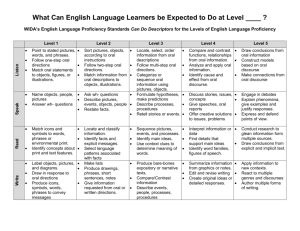
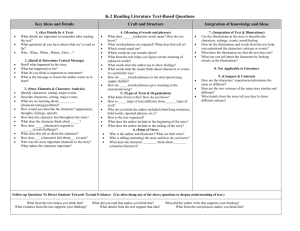
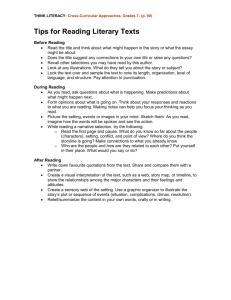
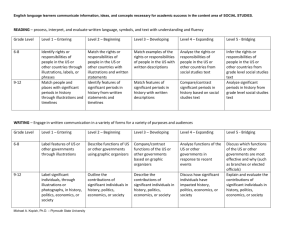
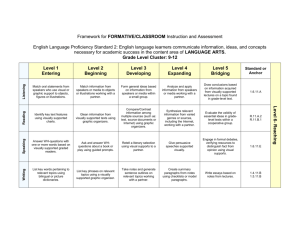
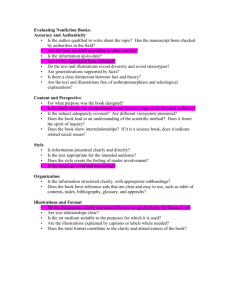
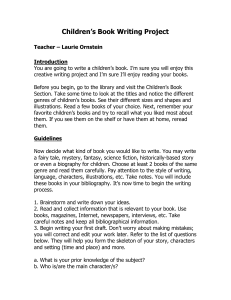
![Creating Worksheets [MS Word, 78 Kb]](http://s3.studylib.net/store/data/006854413_2-7cb1f7a18e46d36d8c2e51b41f5a82fa-300x300.png)
